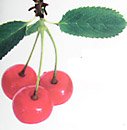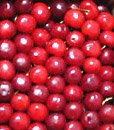Cherry fruit nutrition facts
Wonderfully delicious, cherry fruit is packed full of health-benefiting nutrients and unique antioxidants. Cherries are native to Eastern Europe and Asia Minor regions.
Botanically, the fruit is a “drupe” (stone fruit), belonging to the large Rosaceae family of small tree fruits in the genus, Prunus. Some of the common “drupe” family fruits are plums, peaches, apricots, etc. Although several species of cherries exist, two popular cultivars are wild or sweet cherry and sour or tart cherry. While sweet cherries belong to the species Prunus avium, the tart variety belongs to that of Prunus cerasus.
 |

|
| Cherries. | Tart cherries. |
Cherries are drupe fruits with a central “stony-hard” seed surrounded by fleshy edible pulp. They come in small sizes, measuring about 2 cm in diameter. Externally they are covered by bright "shiny" red or purple, thin peel.
The West Indian cherry, known as acerola (Malpighia emarginata), is native to West Indian islands and grown in Mexico, and Texas regions in North America. Acerola belongs to the tropical fruit-bearing shrubs in the family Malpighiaceae and contains 2-3 tiny seeds. Acerola composes exceptionally high levels of vitamin C and vitamin A than North American and European cherries.
Health benefits of Cherry fruit
Cherry fruit nutrition featured very low-calorific value and negligible fats. Nonetheless, cherries are a rich source of phytonutrients, vitamins, and minerals. Both sweet, as well as tart cherries, are packed with numerous health-benefiting compounds that are essential for wellness.
Cherries are pigment-rich fruits. These pigments, in fact, are polyphenolic flavonoid compounds known as anthocyanin glycosides. Anthocyanins are red, purple, or blue pigments found in many fruits and vegetables, especially concentrated in their skin, known to have powerful antioxidant properties.
Scientific studies have shown that anthocyanins in the cherries are found to act like anti-inflammatory drugs by blocking the actions of enzymes cyclooxygenase-1 and 2. Thus, consumption of cherries may offer potential health effects against chronic painful episodes such as gout arthritis, fibromyalgia (a painful muscle condition), and sports injuries.
Research studies also suggest that antioxidant compounds in tart cherries can help the human body fight against cancers, aging and neurological diseases, and pre-diabetes conditions.
Cherries compose of melatonin antioxidant. Melatonin can cross the blood-brain barrier easily and has soothing effects on the brain neurons, calming down nervous system irritability. It, thus, can help relieve neurosis, insomnia, and headaches.
Further, they are also a minor source of minerals like zinc, iron, potassium, and manganese. Surprisingly good source of copper. Potassium is a beneficial electrolyte that is an important component of cells and body fluids that regulate heart rate and blood pressure.
They, especially tart cherries, are exceptionally rich in health-promoting flavonoid polyphenolic antioxidants such as lutein, zeaxanthin, and β -carotene. These compounds act as protective scavengers against harmful free radicals and reactive oxygen species (ROS) that play a role in aging, cancers, and various disease processes.
Anti-inflammatory property of cherries has been found effective in reducing heart-disease risk factors through scavenging action against free radicals.
Acerola or West Indian cherry has exceptionally very high levels of vitamin-C (1677.6 mg per 100 g or 2796 % of RDA) and vitamin-A (767 IU per 100 g).
| Principle | Nutrient Value | % of DA | |||
|---|---|---|---|---|---|
| Cherry type | Sweet | Tart | Sweet | Tart | |
| Energy | 63 cal | 50 cal | 3% | 2.5% | |
| Carbohydrates | 16.1 g | 12.18 g | 12% | 9% | |
| Protein | 1.06 g | 1.00 g | 2% | 2% | |
| Total Fat | 0.20 g | 0.30 g | 2% | 3% | |
| Cholesterol | 0 mg | 0 mg | 0% | 0% | |
| Dietary Fiber | 2.1 g | 1.6 g | 5.5% | 4% | |
| Vitamins | |||||
| Folates | 4 µg | 8 µg | 1% | 2% | |
| Niacin | 0.154 mg | 0.400 mg | 1% | 2.5% | |
| Pyridoxine | 0.049 mg | 0.044 mg | 4% | 3.5% | |
| Riboflavin | 0.033 mg | 0.040 mg | 2.5% | 3% | |
| Thiamin | 0.027 mg | 0.030 mg | 2% | 2.5% | |
| Vitamin A | 64 IU | 1283 IU | 2.1% | 43% | |
| Vitamin C | 7 mg | 10 mg | 11.5% | 16% | |
| Electrolytes | |||||
| Sodium | 0 mg | 3 mg | 0% | 0.2% | |
| Potassium | 222 mg | 179 mg | 5% | 4% | |
| Minerals | |||||
| Calcium | 13 mg | 16 mg | 1.3% | 1.6% | |
| Copper | 0.060 mg | 0.104 mg | 7% | 11.5% | |
| Iron | 0.36 mg | 0.32 mg | 4.5% | 4% | |
| Magnesium | 11 mg | 9 mg | 3% | 2% | |
| Manganese | 0.070 mg | 0.112mg | 3% | 5% | |
| Phosphorus | 21 mg | 15 mg | 3% | 2% | |
| Zinc | 0.07 mg | 0.10 mg | 0.5% | 0.1% | |
| Phyto-nutrients | |||||
| Carotene-ß | 38 µg | 770 µg | -- | -- | |
| Carotene-α | 0 µg | 0 µg | -- | -- | |
| Lutein-Zeaxanthin | 85 µg | 85 µg | -- | -- | |
Selection and storage
Cherry fruit season lasts from the end of May until August in the United States. Fresh ripe cherries have a short shelf life. In the store, choose cherries that have bright, shiny skin with a green stalk firmly attached at the top end of the fruit.
Keep fresh cherries in the refrigerator. Whenever you wish to eat them, just rinse cherries in water to remove dirt and bring them back to room temperature. Then, gently pat dry with a soft cloth to remove moisture.
Preparation and Serving method
To prepare cherries, remove the stalk, wash them gently in cold water, and pat dry on a soft cloth. Ripe ones can be eaten as a whole including skin to get the maximum benefits.
Sweet cherries are being employed in several recipes,
Sweet cherries can be eaten all alone, without any additions/seasonings.
A fruit cocktail can be prepared with cherry, peach, pineapple, pear and grape.
Add in fruit salads with peach, pear, apricot, and pineapple.
Add dried cherries to fruit cakes, bread, muffins, and cookies.
Use them for desserts, pie fillings, and Toaster Pastries.
Tart cherries are mainly employed in the preparation of sauce, pie fillings, jams, muffins, and cheesecakes. Tart cherry fruit juice is a favorite refreshing drink among athletes and various sports personnel. Dried tart cherries make delicious additions to meals and snacks
≻≻-Back to Fruits from Cherry fruit. Visit here for an impressive list of all varieties of fruits with complete illustrations of their nutrition facts and health benefits.
≻≻-Back to Home page.
Further resources:
Stanford School of Medicine Cancer information Page- Nutrition to Reduce Cancer Risk.